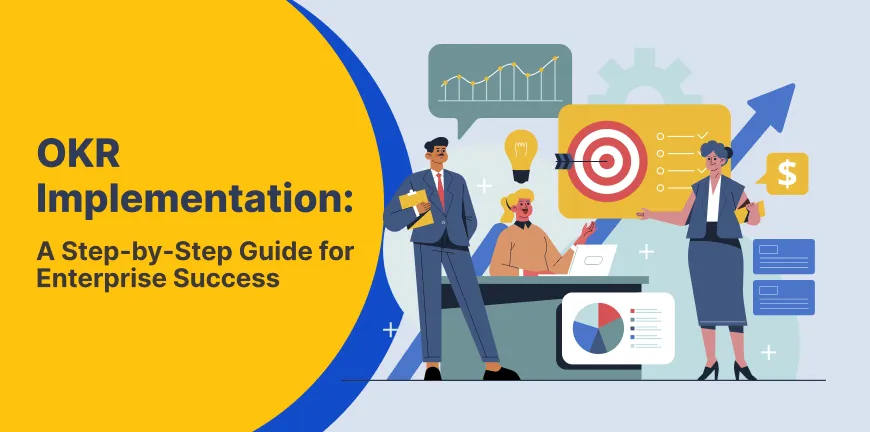
Top 10 Foreign Languages in Demand for Indian Professionals
13/10/2025
What Is IT Staff Augmentation? Meaning, Types, Benefits, and Best Practices
13/10/2025Leaders in every organisation often wonder how they can align their team’s goals with the organisation’s strategy, as it’s crucial for success. It’s important to have a clear roadmap to achieve this. This is where the OKR framework is useful. It provides you with a way to realise these strategies to achieve proper outcomes. It’s a fast-paced business environment, and having proper OKRS is essential to drive performance and achieve alignment. OKRs can be viewed as concrete and measurable strategies.
Our OKR implementation guide will show you how to implement OKRs to achieve better strategic alignment and success.
What are OKRs?
OKRs are Objectives and Key Results. It is a strategy used by organizations that can help manage the goals and objectives of an organization as well as track results. OKRs can keep tabs on the progress of goals and objectives, ensure the organisational strategy is aligned, and help employees understand better how their duties and responsibilities can have a better impact. OKRs set goals for various, distinct fields and areas like software engineering, office operations, non-profits, etc. They even work for personal goals and can be used to get work done at places where leaders don’t use them.
Why Is Implementing OKRs Important for Organisations?
OKRs are instrumental in figuring out the effectiveness of the strategies. The right OKR strategy not only helps organizations achieve their goals within reasonable timelines but also helps individuals feel motivated and engaged about their work. While aligning the two does pose a problem, OKR offers a clean framework that ensures every team member understands how their work contributes to the larger goals of an organisation. Successful implementation of OKR can ensure proper execution, better matching, and create transparency.
- Enhanced focus and alignment across all teams
- There is transparency, and it fosters better accountability
- A higher ability to drive easy-to-measure results in every quarter.
- Much easier to adapt to dynamic market conditions
What are the Steps to Implement OKRs Successfully?
1. Set a clear path and define goals
Before setting any goals for the teams, make sure every employee understands the company’s needs, expectations, and long-term goals. It will help set a tone as to how OKRs can serve your overall strategy. How can you do this? Understand what your company’s purpose is and what they want to achieve, their most important objectives, and talk to all the departments about this.
2. Make everyone aware of OKRs
OKRs must not be just a management tool but should be a mindset across teams. How can this help? By accepting OKRs fully, individuals will be more engaged and happier to work towards common goals. However, to bring in this mindset, organizations must clearly explain the purpose of the OKRs, encourage individuals to open up about their opinions on the OKRs that are being set, be ok with the mistakes they may make, and make sure to tell them that the OKRs are not linked to appraisals, so they don’t have to worry about the increment part.
3. Design effective OKRs
The objectives you set must have meaning and must make sense to everyone. This essentially means the objectives must be in line with key results, must be easy to measure, and must be completed within a certain timeline. You must also have it figured out as to how you plan on achieving these goals and what goals you want to complete.
4. Align OKRs across the entire organization
You must assign tasks to every employee in your organization in a way that the results of it somehow contribute to the long-term goals overall. To ensure this, you must set OKRs that are not just achievable but also align with the roles and responsibilities of employees across various departments.
5. Commencement of a pilot program
Once your OKRs are set, run a trial. This will help you identify loopholes or gaps. You can also get feedback about how the OKRs worked before rolling out the final OKRs. If you must do a trial run, then pick up teams that are open to experimentation, set OKRs every quarter, gauge motivation, track the progress and outcomes of this pilot program.
6. Choose the right tools for tracking
Post the implementation, it’s also essential to track the OKRs. Now this can be done manually using spreadsheets or with the help of an OKR platform. As a company, you can choose a solution that is right for your team based on the number of employees and other unique business needs. For small teams, you can start with Google Sheets, growing companies can use extensive platforms, and tools must facilitate regular updates, comments, and visual tracking.
7. Talk to the team and train them
Once the OKRs are set in motion and are being tracked, you must talk to your team and make them aware of the OKRs’ work. This will make them confident to set and track them. Have meetings about the OKR launch across your organisation, provide proper training for heads and leaders, and create simple OKR templates.
8. Review the OKR progress
Your work isnt over after implementing OKRs. You must also review them to know if they are working. If you think there are areas that aren’t working, modify it. This will help keep the progress constant. Have weekly/bi-weekly team reviews and get updates, check if the leadership style is working and is in the direction it should be, and end-of-quarter meetings to understand the learnings.
9. Modify as required
Once your set OKRs have run their course, you may understand what worked, what didn’t, and what could be changed and modify your OKRs accordingly. Ask your colleagues and employees of different levels as to what can be improved, and see the outcomes you got versus what you expected.
Common Challenges in Implementing OKRs
Improper alignment, unclear about setting proper goals, and being unable to track and measure OKRs are some of the main challenges in implementing OKRs.
1. Wrong alignment and reduced involvement of stakeholders
Wrongly aligned OKRs across teams, individuals, and other organizational levels can lead to a clash in priorities as well as wastage of resources. When you don’t involve stakeholders while planning the OKRs, this leads to a lack of commitment, making it difficult to get buy-in for the new OKR system.
2. Focusing on results rather than progress
Organizations often focus on the results, which can lead to an error in judgment and result in employees feeling dissatisfied as well as lower productivity. Some of the other things that can go wrong are not defining your OKRs clearly, with simple wording, and setting a reasonable number of achievable objectives.
3. Failing to track and measure them appropriately
You can’t just set up OKRs, implement them, and leave them. To make sure they are right and working as per your needs, you must monitor and track them. Also, depending on old data systems and limited metrics can make it difficult to achieve the goals you have in mind for your organization.
4. Cultural and operational problems
Employees who have been with you for a while now and are used to the old and existing processes may find it hard to accept new OKRs and will require training. Not being clear about the organizational goals, progress will lead to mistrust among employees. Not reviewing your OKRs often or gathering feedback can lead to poor results.
Best Practices for OKR Implementation
There are a number of best practices that can be followed to implement OKRs correctly.
Make sure stakeholders take part in setting OKRS
Your key stakeholders, like department heads, higher-grade employees, and managers, must take part in creating OKRs. They can provide a perspective of their own about what works and doesn’t in their areas. This allows everyone to have a say in how the tasks and duties can help achieve the goals, promoting higher engagement.
Focus on quality and quantity
Of course, you must have a good number of OKRs to see success and progress. But you must also remember that it’s not about quantity but about quality. So it’s better to set OKRs that are meaningful and achievable. This helps maintain focus on what matters and avoids employee burnout and lower productivity.
Revise OKRs as and when necessary
Your OKRs are not set in stone. When you have your reviews, you come to know what’s working and what’s not. Based on this, you can modify the OKRs.
Align OKRs with the organization’s long-term strategy
Your OKRs must be such that every employee is performing a task that is contributing to them in one way or another. When employees are involved in the bigger picture, not only do they feel valued and motivated. This also helps organizations achieve their goals much faster.
Make employees aware and communicate the OKRS clearly
Communicating the OKRs clearly is the first and most important step. Your employees must know exactly what you are trying to achieve through the objectives and goals you have set. They must also know what their role is in helping you achieve it.
Train and support employees
After making your employees aware of what the OKRs are, you must train them with the necessary tools and materials to help them understand them. This part is important as the more they understand, the more engaged they will feel in developing and achieving the OKRs.
Future Trends in OKR Implementation
Your business will grow in time. This means your OKRs must grow and change as well. Emerging practices in AI, automation, and remote work are reshaping the future of OKRs:
- Emerging Practices: Automated insights will help employees not stray away from their tasks and duties and stay aligned with the OKRs. OKR management platforms now offer predictive analytics for proactive decision-making.
- Impact of Remote Work: Remote work underscores the need for asynchronous communication and transparent OKR processes, enabling teams to remain aligned regardless of physical location.
FAQs- Frequently Asked Questions
1. What is OKR implementation in organizations?
OKR implementation in organizations is a strategy that maps out objectives and tracks results. It is something that creates a balance between keeping employees engaged and productive and achieving goals.
2. What are the steps to implement OKRs?
Defining clear objectives and results, communicating the OKRs to everyone, starting off a pilot program, assigning individuals who are ready to test it out, reviewing the progress, and modifying it to create a final OKR are some key steps.
3. What are the benefits of implementing OKRs in a company?
Implementing OKRs (Objectives and Key Results) provides companies with alignment, focus, transparency, accountability, and ambitious goal-setting by connecting individual efforts to company-wide strategic goals, promoting teamwork, and enabling agile adjustments through measurable progress tracking.
4. What are the common mistakes to avoid when implementing OKRs?
Not talking to your employees about it and making them understand, setting goals that are too difficult to achieve, not matching OKRs with organizational goals, and not tracking OKRs after they are implemented.
5. What tools help in implementing OKRs effectively?
You can use spreadsheets, such as Google Sheets, for simple tracking of OKRs. There are also dedicated OKR software with advanced features that you can use if your organization is big.
6. What is the difference between OKRs and KPIs in implementation?
OKRs typically have quarterly cycles (depending on the cadence of your teams), while KPIs are high-level, tracking larger business goals.
7. What are the best practices for OKR implementation?
Best practices for OKR implementation include aligning them to broader strategy, setting challenging but measurable Key Results, ensuring transparency and visibility, conducting regular check-ins, fostering continuous communication and adaptation, providing training and coaching, and securing leadership commitment to drive engagement and accountability.
Contact Us For Business Enquiry

Suresh Ramkrishna
Suresh Ramkrishna is the Operations Manager at Alp Consulting Ltd., with over 30 years of extensive experience spanning recruitment operations, sourcing, supply chain management, and client relations. At Alp, he leads the Search & Staffing Practice, specializing in bilingual and niche skill hiring while overseeing Japanese language and TITP (Technical Intern Training Program) initiatives. He also manages NAPS (National Apprenticeship Promotion Scheme) training programs, fostering skill development and workforce readiness across industries. Previously, he spent over two decades in the apparel export industry, managing vendor development and international sourcing for top global brands. Suresh’s leadership blends strategic talent acquisition with operational excellence across diverse industries.




